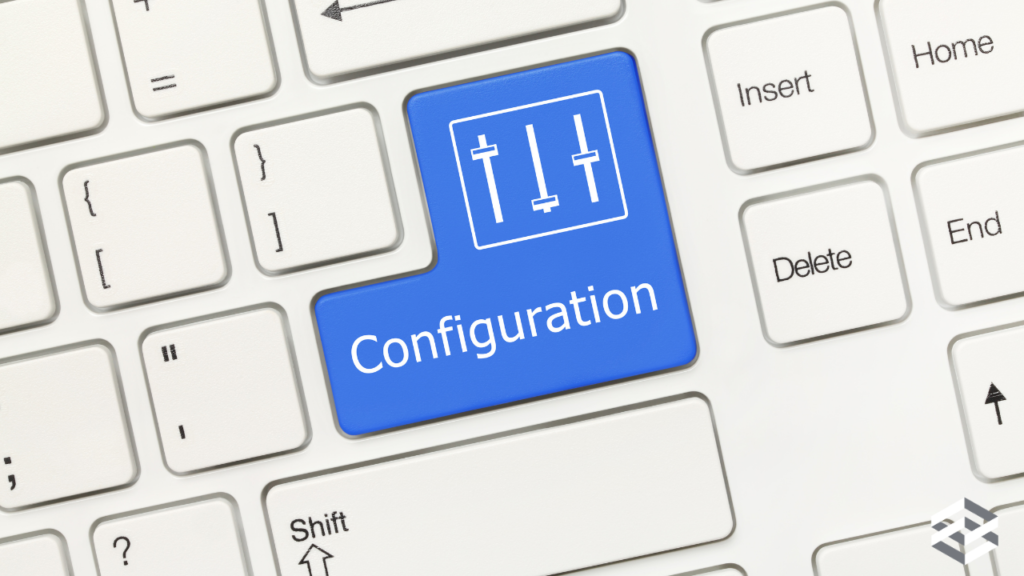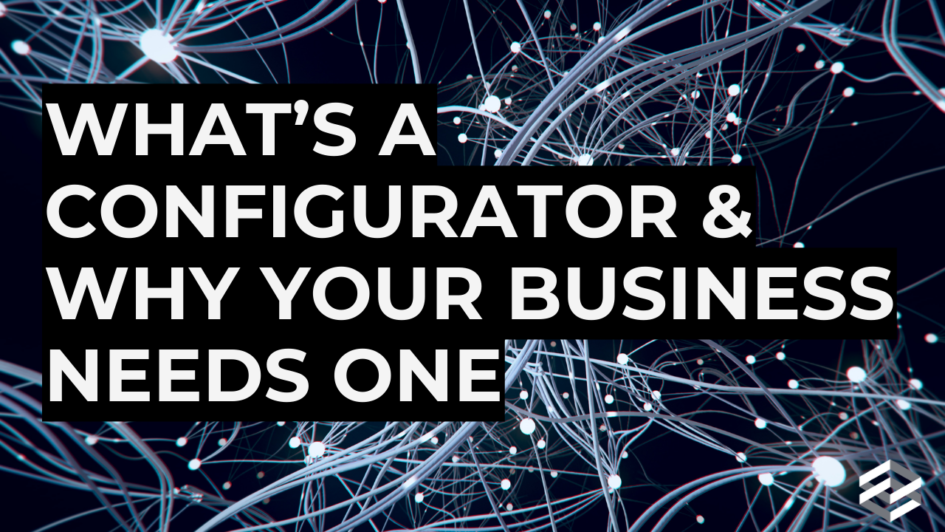Moving your operations online can seem daunting, especially when dealing with customizable products. Fortunately, there are many options available today that make customization in your e-commerce store easy to implement and intuitive to use. Whether it’s as simple as choosing a color or adding a name to an item, or as complex as configuring multiple components to meet precise specifications, the right tools can make all the difference.
What is a Product Configurator?
A product configurator is a tool that allows customers to customize products according to their specific needs and preferences directly on an e-commerce platform. In a B2B (business-to-business) e-commerce environment, product configurators are particularly valuable because they enable businesses to tailor complex products, often with multiple components, to meet precise specifications. This could involve selecting different materials, dimensions, colors, features, or accessories that are necessary for the buyer’s specific application or project.
Product configurators can range from simple options like choosing sizes or colors to more advanced setups where customers can build a product from the ground up, selecting each component, material, and feature. For B2B companies, where the products sold are often more complex and customizable, configurators provide a critical interface between the customer’s needs and the company’s offerings.
Challenges of Offering a Product Configurator
Complexity in Development: Developing a robust product configurator can be technically challenging, especially when dealing with complex products that have numerous options and dependencies. It requires deep integration with inventory systems, pricing engines, and sometimes even manufacturing processes to ensure that the configurations selected by customers are feasible and cost-effective.
Data Management: Managing the data behind a product configurator can be daunting. Each option and combination must be accounted for, and this data needs to be accurate and up-to-date. Inaccuracies can lead to customer dissatisfaction, order errors, and production inefficiencies.
User Experience Design: Ensuring that the configurator is user-friendly is crucial. The tool must be intuitive, allowing customers to navigate the options and understand the impact of their choices easily. A poorly designed configurator can overwhelm users, leading to frustration and abandoned sales.
Pricing Complexity: As customers configure products, the pricing needs to adjust dynamically based on their selections. This requires a sophisticated pricing engine capable of handling complex calculations in real-time.
Integration with Backend Systems: A product configurator must integrate seamlessly with backend systems, including ERP (Enterprise Resource Planning), CRM (Customer Relationship Management), and supply chain management. This ensures that the configured products can be produced, tracked, and delivered according to the customer’s specifications.

Selecting an E-Commerce Solution That Meets Your Configuration Needs
When selecting an e-commerce solution to meet your business’s product configuration needs, it’s important to consider several key factors to ensure that the platform not only supports your current requirements but also scales with your growth. Here’s what you should look for:
- Advanced Product Configuration Capabilities
- Flexible Configuration Options: The e-commerce platform should support a wide range of customization options, including varying product attributes, components, and features. It should handle complex products with multiple dependencies, allowing customers to configure products from the ground up.
- Real-Time Configuration: Look for a platform that provides real-time updates as customers configure products. This includes live pricing adjustments, availability checks, and visual previews. Real-time data ensures that customers can see the impact of their choices instantly.
- Conditional Logic: The platform should allow for conditional logic in product configuration. For example, if a customer selects a specific feature, certain other options might be automatically enabled or disabled based on that selection. This ensures that the configuration process is logical and error-free.
- Integration with Backend Systems
- ERP and CRM Integration: Ensure that the platform integrates seamlessly with your existing Enterprise Resource Planning (ERP) and Customer Relationship Management (CRM) systems. This integration is critical for managing orders, inventory, and customer data effectively.
- Supply Chain Management: The e-commerce solution should connect with your supply chain management system to ensure that configured products can be produced and delivered on time. This integration helps streamline operations and reduce lead times.
- Pricing Engines: If your product configurations involve complex pricing models, the platform should integrate with advanced pricing engines. This ensures accurate pricing based on customer selections and allows for dynamic pricing strategies.
- User-Friendly Interface
- Intuitive Design: The platform should offer a user-friendly interface that makes it easy for customers to configure products. This includes a clean, intuitive layout, clear instructions, and a step-by-step process that guides users through their choices.
- Visual Product Configurators: Visual configurators are a must for complex products. They allow customers to see a visual representation of the product as they configure it, making the process more engaging and reducing the chances of errors.
- Mobile Optimization: Ensure that the configurator is mobile-friendly, allowing customers to configure products seamlessly on any device. As mobile commerce grows, this is becoming increasingly important.
- Scalability and Customization
- Scalability: The platform should be able to scale with your business as your needs grow. This includes handling an increasing number of configurations, users, and transactions without compromising performance.
- Customizability: Look for a solution that is customizable to your specific business needs. This might include custom workflows, unique product attributes, or specific integration requirements. A platform with a flexible API is often a good choice for businesses with unique configuration needs.
- Performance and Reliability
- Speed and Performance: The configurator should be fast and responsive, even when handling complex products with many options. Slow performance can frustrate users and lead to higher abandonment rates.
- Reliability and Uptime: Choose a platform with a proven track record of reliability and high uptime. The last thing you want is for your configurator to go down during peak business hours.
- Security and Compliance
- Data Security: Ensure the platform offers robust security features, including data encryption, secure payment processing, and compliance with industry standards (e.g., GDPR, PCI-DSS). This is particularly important in B2B transactions where sensitive customer data and large orders are involved.
- Compliance Features: If your business operates in a regulated industry, make sure the platform supports compliance requirements specific to your sector. This could include features like audit trails, reporting, and data retention policies.
- Support and Community
- Vendor Support: Look for a platform that offers strong customer support, including implementation assistance, training, and ongoing technical support. This is especially important if you’re dealing with a complex configuration setup.
- Community and Resources: A strong user community and access to resources such as forums, tutorials, and case studies can be incredibly helpful. These resources can provide insights and tips on how to get the most out of the platform.
- Analytics and Reporting
- Configuration Analytics: The platform should offer robust analytics and reporting tools that allow you to track how customers are using the configurator. Insights into which configurations are most popular, where customers drop off, and the overall performance of the tool can help you optimize and improve the configuration experience.
- Sales and Conversion Tracking: Integration with your analytics tools should allow you to track the impact of product configurators on sales and conversions, helping you measure ROI and adjust strategies as needed.
- Customization and Flexibility
- Custom Workflow Capabilities: Depending on the complexity of your products, you might need custom workflows in the configuration process. Ensure the platform allows you to tailor workflows to fit your specific needs.
- Flexible APIs: If your business requires unique features or integrations, look for a platform with flexible APIs. This will enable you to extend the platform’s capabilities and integrate it with other tools and services as needed.

Rely on a Systems Integrator to Assemble an E-Commerce Solution That Meets Your Configuration Needs
Working with a systems integrator can be highly beneficial, especially when dealing with the complexities of implementing a product configurator in a B2B e-commerce environment. Here’s how partnering with a systems integrator like DigiCommerce can help your business:
Expertise in Complex Integrations
Implementing a product configurator that meets the needs of a B2B business often requires deep technical expertise, particularly in integrating the configurator with existing systems like ERP, CRM, and supply chain management platforms. A systems integrator brings the specialized knowledge needed to ensure these integrations are done smoothly and efficiently.
DigiCommerce has extensive experience composing e-commerce solutions that allow clients in the automotive, manufacturing, and industrial spaces to offer highly configurable products. DigiCommerce has developed a configurator accelerator that is designed to integrate with any headless e-commerce platform and significantly reduce the complexity and time required for implementation.
Customization and Tailored Solutions
A systems integrator can provide customized solutions that are tailored to your specific business needs. This includes adapting the product configurator to handle unique product attributes, pricing models, and workflows that are specific to your industry.
DigiCommerce’s configurator accelerator is particularly advantageous here because it allows for customization without the need for third-party tools, reducing the potential for conflicts or integration issues and ensuring that the solution is perfectly aligned with your business processes.
Seamless Integration with Existing Systems
One of the biggest challenges in implementing a product configurator is ensuring it integrates seamlessly with your existing systems. This integration is crucial for managing inventory, pricing, and order processing in real-time.
An experienced systems integrator can handle this integration, ensuring that your product configurator works in harmony with your existing ERP, CRM, and supply chain management systems.
Focus on Core Business Activities
Implementing a product configurator can be a resource-intensive process, diverting attention and resources from your core business activities. By partnering with a systems integrator, you can offload the technical aspects of the project, allowing your internal teams to focus on what they do best.
Ongoing Support and Maintenance
After the initial implementation, ongoing support and maintenance are crucial to ensure that your e-commerce solution continues to operate smoothly and evolves with your business needs. A systems integrator provides the necessary support to troubleshoot issues, implement updates, and optimize the configurator over time.
Scalability for Future Growth
As your business grows, your e-commerce environment will need to scale to accommodate more products, users, and complex configurations. A systems integrator can design your configurator with scalability in mind, ensuring it can grow alongside your business.
Wrapping up
Selecting the right e-commerce platform for your product configuration needs and partnering with an experienced systems integrator will ensure you can deliver a seamless and effective experience for your B2B customers. By focusing on the key features mentioned above, you can choose a solution that not only meets your current needs but also supports your business’s growth in the future.
If you want to find out more about the configurator accelerator and see if it is right for your business, contact us!

